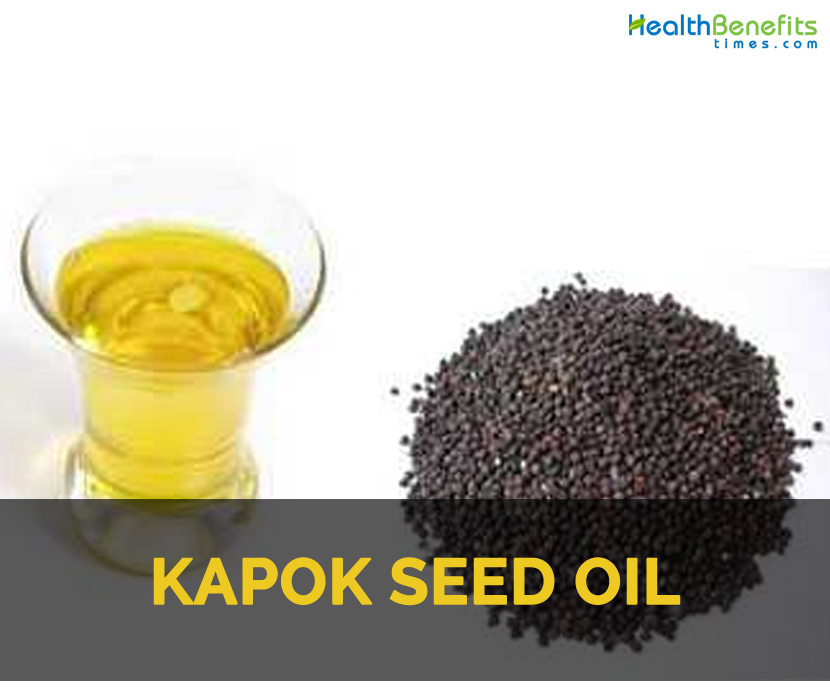| Kapok seed oil uses Quick Facts | |
|---|---|
| Name: | Kapok seed oil uses |
| Scientific Name: | Ceiba Pentandra |
| Origin | It is native to Central America, Mexico, Northern South America and Caribbean. It is produced in Malaysia, Indonesia and India. |
| Colors | Yellowish |
| Health benefits | Relieve rheumatism, Cure wounds |
| Name | Kapok seed oil uses |
|---|---|
| Scientific Name of Kapok | Ceiba Pentandra |
| Native | It is native to Central America, Mexico, Northern South America and Caribbean. It is produced in Malaysia, Indonesia and India. |
| Common/English Name of Kapok | Kapok oil, Java cotton, Silk cotton, Java kapok, Ceiba, Samauma, Cotton silk tree, Cotton tree, Devil’s tree, Jumbie tree, White cotton tree |
| Name in Other Languages of Kapok | Spanish: Aceite de kapok; French: Huile de kapok; Spanish: Ceiba; Haitian Creole: Mapou; Portuguese (Brazilian): Sumauma; Surinamese: Kankantrie; French: Fromagerfart; Hindi: Safed semal (सफ़ेद सेमल); Malayalam: Pannimaram; Manipuri: Moreh Tera (মোৰেহ তেৰা); Tamil: Ilavam (இலவம்); Tagalog/Filipino: Bulac, Bulak; Telugu: Tellaburaga; Kannada: Dudi; Marathi: Samali; Bengali: Shwet Simul (শ্ৱেত সিমল); Sanskrit: Kutashalmali; Samoan: Vavae; Ashante, Fanteen and Twi: Onyina, Onyãã; Sinhala: Kotta; Indonesian: Kapuk Randu, Randu; Mandingo: Banã, Bantã (Malinké), Bãnda (Dioula), Banti; Odia: Semili Tula; Arabic: Shajaret al kutun, Rum (Chad); Bambara: Bànan, Bàna; Bengali: Setsimul, Schwetsimul; Burmese: Thinbawle; Chinese: Zhua wa mu mia, Ji bei mu mian, Ji bei mian; Danish: Silkebomuldstræ, Kapoktræ; Dutch: Kapokboom; Finnish: Capoc, Seiba, Kapokkipuu; French: Arbre coton, Arbre à kapok, Arbre de Dieu, Arbre kapok, Capoquier, Bois coton, Faux cotonnier, Cotonnier de l’Inde, Kapokier, Fromager; German: Baumwollbaum, Kapokbaum, Fuma, Wollbaum; Hausa: Riimii, Riimaayee; Hindi: Katan, Safed semul, Safed savara, Safed simul, Safed simal; Italian: Pianta del kapok, Albero del kapok; Japanese: Kiwata kapokku, Kapokku; Khmer: Kor, Koo; Laotian: Nguiz baanz, Kokuiyu; Malay:- Surinam: Daun randu, Kabuk abu, Kakabu, Kakantrie, Kankantri; Indonesia: Kapok, Kapuk randu, Pohon kapok, Mengkapas, Pohon randu; Marathi: Safetasavara; Portuguese: Arvore-da-lã, Barriguda, Arvore-da-seda, Barriguda de espinho, Mafumeira, Mai-das-arvores, Paina, Paineira, Paina-lisa, Poilão, Samaúma-cabeluda, Polão, Samaúna da várzea, Sumauma da mata, Samaúma-lisa, Sumaúma, Sumauma de terra firme, Sumaúma-da-várzea, Sumaúma-branca, Sumaúma-de-macaco, Sumaúma-rosada, Sumaumeira, Sumaúma-verdadeira; Sanskrit: Seta salmali, Shweta shalmali, Shvetasalmali; Sinhalese: Elavam, Kottapulung, Imbul, Pulunimbal, Pulung; Spanish: Arbol capoc, Arbol de la seda, Arbol de seda, Bonga, Ceiba blanca, Capoquero, Ceiba de lana, Ceiba yuca, Ceiba juca, Ceibo, Ceibo jabillo, Huimba, Hoja de yuca, Mosmote, Pochota, Peem, Pochote, Yaxché, Toborochi, Yuca; Swahili: Msufi, Mbuyu; Swedish: Kapok; Tamil: Ilavu, Illavam panju, Ilavum, Pancu, Panjirnaram, Panji, Ulagamaram, Panjumaram; Telugu: Tella buruga; Thai: Ngao, Ngio sai, Ngio noi, Nun, Ngio soi; Urdu: Sambal; Vietnamese: Bông gòn; Yoruba: Araba, Ogungun, Egun; |
| Color | Yellowish |
| Odor | Mild, pleasant |
Awesome


